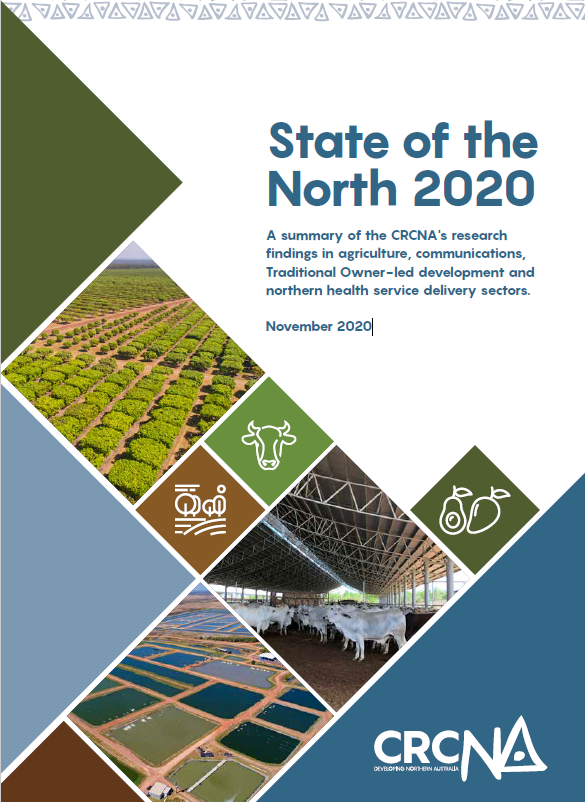Northern Australia has the potential to be at the forefront of our country’s economic recovery from COVID-19, but only if there is greater collaboration between government and industry to unite the region and release its full economic potential, according to a report launched from the Cooperative Research Centre for Developing Northern Australia (CRCNA).
The State of the North 2020 report is a first-of-its-kind roadmap for the economic development of Northern Australia, the broad region of Australia north of the Tropic of Capricorn, and highlights the urgent need to develop a consistent, streamlined, and unified approach to growing the region.
CRCNA Chair Sheriden Morris said the report was a result of three years of research in consultation with the region’s key industries.
“The impediments for developing Northern Australia are well known, but the State of the North report both quantifies these impediments and lays out what is really needed to shape the prosperity of Northern Australia for decades to come,” she said.
The State of the North report identifies the main challenges to growing jobs, investment and development in Northern Australia and, critically, outlines solutions to make the region more able to attract sensible and sustainable investment. It also identifies pathways to improve the productivity and competitiveness of the region’s agricultural and health sectors.
“The industries we’ve worked with want to see the government and industry work better together to prioritise infrastructure and supply chains in the Northern Australia, and upskill local workforces in a way that meets the long-term needs of the north. They are ready to take advantage of the opportunities that have been identified, and now we must bring all key stakeholders together to collectively map the focus areas for investment. ”
There is a body of work that is needed to enable the current regulatory framework for approving agricultural development to work more effectively to attract quality investment and to protect environmental and cultural assets in the landscape (e.g. land tenure, water allocation, etc). There is also a significant opportunity to harmonise regulatory approaches more across state and territory jurisdictions.
“Our research with the agricultural sector has revealed that the industry believes there’s a lack of policy clarity about where sustainable agricultural developments will be acceptable to all three levels of government and their community,” said Ms Morris.
“As a result, there are latent opportunities in Northern Australia, such as 500,000 to 700,000 hectares of land suitable for marine farming. We are also sitting on $13 billion in untapped beef export potential.”
“The report also notes there is potential for up to 2,300 new direct jobs to be created in the aquaculture in the next 10 years, plus a further 600 jobs in forestry, if the region attracts greater investment.”
Health service delivery in Northern Australia
Healthcare and social assistance industries across the region already employ 13 per cent of the region’s 1.3 million people and is the largest employing sector in Northern Australia.
Sector analysis from the report notes the region faces ongoing health workforce shortages and high turnover, and there is a challenge in providing integrated and optimal care for local patients.
“The industry points to an opportunity to establish a permanent cross-jurisdictional health service body and workforce network that caters specifically to Northern Australia. This would enable shared strategic planning and the implementation of new healthcare initiatives designed specifically for the region,” said Ms Morris.
Solutions must be ‘North-centric’
The State of the North report notes the unique conditions of Northern Australia mean solutions need to be considered, developed and applied horizontally across the north, , if the full growth potential of the region is to be unlocked.
Other possible initiatives outlined in the report include the need for the development of a Northern Australia Supply Chain Fund, to enable supply chain collaboration and partnerships that are specific to the challenges facing the region. There is also an opportunity for the development of Indigenous pastoral estate, which contributes to economic development for local communities on traditional lands.
“The solutions in the report already have broad industry support and we will continue to work with key industry groups to progress these ideas as part of the next stage of research collaboration to help make the region more appealing to investment,” said Ms Morris.
Building prosperity for decades to come
As part of its next phase of work, the CRCNA will work with governments and the industry to facilitate further research on what is needed to deliver real economic impact for Northern Australia.
“It is clear that the current framework for planning across the agriculture and healthcare sectors across Northern Australia is inadequate, but there is a latent opportunity for governments, private sector, and the community to work better together,” said Ms Morris.
“The CRCNA calls on the government, industry, and private sector to reach out to be part of the next phase of the Northern Australia development agenda to help support the prosperity of the region.”
Read report here.
Media enquiries
Carla Keith, CRCNA Communications Manager 0499 330 051


